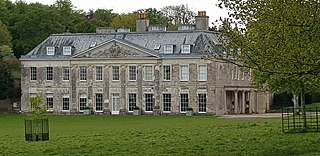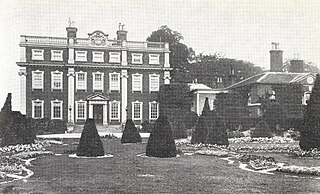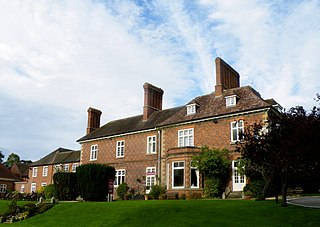
The Smalbroke family (also spelled Smallbrook) was a powerful landed gentry family between the early 15th and early 19th centuries, owning large areas of land in Birmingham, England.

The Smalbroke family (also spelled Smallbrook) was a powerful landed gentry family between the early 15th and early 19th centuries, owning large areas of land in Birmingham, England.
The family are first recorded in the Birmingham in 1425, when William Smalbroke is recorded as a trustee of charitable property at Yardley. John Smalbroke was recorded as 'yoman' in 1440. [1] It is believed that the family remained yeomen in Yardley throughout the 15th century. The family is again referenced as being in Birmingham in a record of Richard Smalbroke occupying a tenement and croft in Park Street at the time of the 1553 survey of Birmingham. Richard was a man of local importance to Birmingham, serving as a bailiff for a number of years. He was instrumental in the foundation of King Edwards School in New Street. He also owned a shop on the High Street, dealing in ironwares, spices and textiles. [2] He was married to Joane Upchurch. He died in 1575, leaving two sons; Richard and Thomas Smalbroke; and three daughters; Mary, Bridgett and Dorothy Smalbroke. [3]
Richard's son, also named Richard, was born in 1553. He married Margaret Hall (d. 22 December 1573 [4] ) on 17 August 1568, [4] the young widow of Richard Greswolde with whom she had two children; Henry and Thomas Greswolde. She had three children with Richard Smalbroke; Robert, Joan and Richard Smalbroke Jnr. [5] Their son named Richard died at a young age on 13 October 1573. [4] Following the death of Margaret in late 1573, Richard remarried to a woman named Elizabeth Kinnersley, [6] with whom he had no children. [3] In 1590, Richard built Blakesley Hall on farmland he owned in Yardley, which is indicated by his initials inscribed above the doorway. [7] The family farmed at the hall and had other buildings in the surrounding area which were lost over time. Throughout the 16th century, the family kept detailed logs of the family accounts, documenting the way the family estate was built up.
Richard's sister, Mary, who was born around 1546, married Richard Stokes in 1557. They had one daughter named Elizabeth. Mary died around June 1591. [3] Bridgett, another of Richard's sisters, was born about 1555. She married Ambrose Rotton on the same day as her sister, Mary, at St Martin's, Birmingham. She died in December 1620 in Aston eight children; John, Robert, Anne, Elizabeth, Richard, Thomas, Ambrose and Henry. She was buried on 28 December 1620. Her husband had died the year before on 2 April. [8] The other sister, Dorothy, was born around 1556. She married Richard Garratt on 24 January 1579/1580. She had no children. [3]
Richard's brother, Thomas Smalbroke, whose birth date is unknown, married Elizabeth Colmore of the wealthy Colmore family in Birmingham on 20 November 1570. Together, they had eight children; Richard Jnr., Elizabeth, Anne, Daratie, Thomas, John, Robert and Bridget. He died in 1608. [3]
Thomas Smalbroke's son, also called Thomas Smalbroke, was born in 1585. Thomas Smalbroke kept detailed accounts of his payments of tithes on agricultural property in the family's account book. In 1613, Richard Smalbroke, his uncle, died leaving six fields to Thomas in his will. Blakesley Hall passed to Richard's wife, Barbara. Barbara subsequently married into the gentry, firstly to Henry Devereux of Castle Bromwich Hall and, after his death, to Aylmer Folliot of Pirton Court in Pershore. Aylmer and Barbara had 12 children who all lived at Blakesley Hall. Their eldest son, named Aylmer after his father, inherited the hall in 1679 when his mother died at the age of 82. Aylmer never married and when he died in 1684, he left Blakesley Hall to his brother Robert, who lived in Ireland. Robert had a successful military career and did not want take on the Yardley property. Therefore, one year after his brother's death, in 1685, Robert sold Blakesley Hall to the Rector of Solihull for £1261 and 10s. [2]
Thomas Smalbroke's accounts show the difference between his six fields in 1608 to his twenty properties in 1646. Thomas Smalbroke died in 1649. [9] Thomas married three times in his life, including a marriage to Elizabeth Rotton, his cousin, in 1607. [9] He had seven children with Elizabeth; Thomas, Richard, Joseph, William, Samuel, Samuel and Sara. [9] Thomas died before his father in 1636. [10] By the time his father died, Richard was the eldest and inherited the largest proportion of the estate. Richard continued enlarging the estates through the English Civil War and Commonwealth. In 1657, Richard sold land in Bordesley to a man named William Hawkes. [11] He also married three times to Anne Hawkins, Judith Gough and Margaret Knight. [12] He had a son, Samuel, with his first wife, Anne. [12] Richard's third wife was Margaret Knight, widow of a successful London lawyer whose family owned an estate at Rowington, Warwickshire. Richard had a daughter named Grace with Margaret. [12] Margaret died in 1692. [13]
The family's ties with the Knight family were strengthened when Richard's son, Samuel Smalbroke, married Elizabeth Knight on 14 February 1665. [14] By 1682, Samuel Smalbroke was calling himself 'gentleman of Rowington'. It was Samuel Smalbroke's acquisition of the Rowington estate which completed the family's transition from burgesses to country gentlemen. Samuel's marriage to Elizabeth Knight produced two children; Richard and Elizabeth Smalbroke. [14] Richard Smalbroke was born in 1672 at 19 High Street in Birmingham. [15] He was baptised on 3 November 1672 at St Martin's, Birmingham. [15] Elizabeth was born around 1676 and married John Staunton on 26 December 1699. [16] Samuel died on 21 May 1701. [14]
Richard was educated at Magdalen College in Oxford. [17] Here he achieved a Bachelor of Arts in 1691, to a Master of Arts in 1694. He also achieved a Bachelor of Divinity in 1706, to a Doctor of Divinity in 1708. He obtained a fellowship and, in 1712, became chaplain to Archbishop Thomas Tenison and treasurer of Llandaff, Wales. In 1717, he was made prebend of Hereford. On 2 February 1723, he was consecrated as Bishop of St David's [18] from which he was moved to Bishop of Lichfield and Coventry on 20 February 1730. [18] Also in 1730, he donated £100 to Magdalen College for the construction of new buildings. He published eleven sermons between 1706 and 1732, three charges and over 22 controversial pieces. [18] He was involved in many disputes, which were said to have weakened his writing ability. [17]
Bishop Smalbroke married Catherine Brooks, a sister of Archdeacon Brooks, with whom he had five sons and four daughters; Elizabeth, Thomas, Catherine, Richard, William, Mary, Samuel, Anne and John. [15] Elizabeth never married [19] as did Thomas who died on 2 July 1778. [20] He settled the family estate on three of his sons, Richard, William and Samuel shortly before his death on 22 December 1749 [15] [18] (though stated by Clarke as 22 September). [17]
John Smalbroke died as a baby on 20 August 1722. [21] William died on 9 June 1797 and was buried in Westminster Abbey on 17 June. [22] He had never married. [22] Samuel Smalbroke became the prebend of Hansacre in 1744 till 1749. [23] He, apparently, exchanged this for the title of prebend of Tarvin, Cheshire, and of Statfold in 1749. [23] Anne Smalbroke married a man known only as Dr. Parker. [24]
Samuel Smalbroke died on 27 July 1803 in Wem, Shropshire. He was buried on 5 August 1803 in Lichfield Cathedral. [25]
Richard Smalbroke, who died on 8 May 1805 [26] at an advanced age, was the last surviving son of the bishop. He was buried in Westminster Abbey. [26] On his death, the family property passed to the surviving children of his sister Catherine, who had married the Reverend William Vyse in 1733; the Rev. Dr. William Vyse, rector of Lambeth (d. 1816) and General Richard Vyse (d. 1825). The estate then passed to General Vyse's successors, the Howard-Vyse family of Stoke Park, Stoke Poges. The intermarriage of the Smalbroke and Vyse families added a substantial landholding in Staffordshire to the existing estate, which was thereafter administered as part of the Birmingham estate, as evidenced by the rentals, which reveal an annual estate income of around £1,000 by the 1820s. It was at this point that the Smalbroke surname was lost.
The Smalbroke name, also spelled Smallbrook, is remembered by the road Smallbrook Queensway, formerly Smallbrook Street, in Birmingham City Centre. [27] [28] The street received its name from the association of being close to small plots of land owned by Bishop Richard Smalbroke. He leased out the land to Samuel Vaughton, a gunsmith, in 1707. [29] A wall tablet is located in Lichfield Cathedral commemorating Bishop Richard Smalbroke. [30]
The records of the Howard-Vyse family's estate at Stoke Place, Stoke Poges, are in the Centre for Buckinghamshire Studies. Birmingham Reference Library and Birmingham City Archives contain a calendar of estates owned by the Smalbroke family in Staffordshire, Warwickshire and Buckinghamshire. The records were deposited by Major-General Sir Richard Howard-Vyse, Buckinghamshire, through Messrs. Chesshire Gibson & Co, Birmingham and Buckinghamshire Record Office. The collection reached the City Archives in two deposits, received in 1937 and 1958. [31]

Shugborough Hall is a stately home near Great Haywood, Staffordshire, England.

Thomas Patrick John Anson, 5th Earl of Lichfield, was an English photographer from the Anson family. He inherited the Earldom of Lichfield in 1960 from his paternal grandfather. In his professional practice he was known as Patrick Lichfield.

Yardley is an area in east Birmingham, England. It is also a council constituency, managed by its own district committee. Historically it lay within Worcestershire.
The so-called Pett Dynasty was a family of shipwrights who prospered in England between the 15th and 17th centuries. It was once said of the family that they were "so knit together that the Devil himself could not discover them". This saying refers to the era during which Samuel Pepys was much involved in getting royal aid for Ann Pett, widow of Christopher Pett. The Petts Wood district of south-east London is named for the family.

Blakesley Hall, a grade II* listed building is a Tudor hall on Blakesley Road in Yardley, Birmingham, England. It is one of the oldest buildings in Birmingham and is a typical example of Tudor architecture with the use of darkened timber and wattle-and-daub infill, with an external lime render which is painted white. The extensive use of close studding and herringbone patterns on all sides of the house make this a home that was designed to show the wealth and status of the owner. The house is also jettied on all sides. At the rear of the hall, built on the back of the chimney, is a brick kitchen block dating from circa 1650.
Lawrence Washington was a High Church rector of the Church of England. He was an early ancestor to the Washington family of Virginia, being the great-great-grandfather of U.S. President George Washington.

Charborough House, also known as Charborough Park, is a Grade I listed building, the manor house of the ancient manor of Charborough. The house is between the villages of Sturminster Marshall and Bere Regis in Dorset, England.

Gilbertstone is a residential suburban area straddling the border of Yardley and South Yardley in Birmingham, West Midlands.

Richard Smallbrooke was an English churchman, Bishop of St David's and then of Lichfield and Coventry.

Thomas William Anson, 1st Earl of Lichfield PC, previously known as The Viscount Anson from 1818 to 1831, was a British Whig politician from the Anson family. He served under Lord Grey and Lord Melbourne as Master of the Buckhounds between 1830 and 1834 and under Melbourne Postmaster General between 1835 and 1841. His gambling and lavish entertaining got him heavily into debt and he was forced to sell off the entire contents of his Shugborough Hall estate.

Swinfen Hall is an 18th-century country mansion house, now converted into a hotel, situated at Swinfen, in the Lichfield District of Staffordshire in England. It is a Grade II* listed building.

General Richard Vyse or Vise FRSE was a British general, and briefly a Member of Parliament for Beverley.
Sir Thomas Luttrell was a wealthy Anglo-Irish landowner of the sixteenth-century Irish Pale. He was also a distinguished lawyer and judge who held the offices of King's Serjeant, Solicitor General for Ireland and Chief Justice of the Irish Common Pleas.

Fowelscombe is a historic manor in the parish of Ugborough in Devon, England. The large ancient manor house known as Fowelscombe House survives only as an ivy-covered "romantic ruin" overgrown by trees and nettles, situated 1 mile south-east of the village of Ugborough. The ruins are a Grade II listed building.
The Gurneys were an influential family of English Quakers, who had a major part in the development of Norwich, England. They established Gurney's Bank in 1770, which merged into Barclays Bank in 1896. Members of the family still live in the United Kingdom.
Anne St Leger was a niece of two kings of England, Edward IV and Richard III. Before she was eight years old, she had inherited a vast fortune and been disinherited of it. Married at 14, she had eleven children and is a link in the maternal line that was used to identify the remains of Richard III.
Sir Edward Devereux was an English politician who sat in the House of Commons, and was an English Baronet.

Dolobran, in the county of Montgomeryshire in Wales, is a historic estate which was the earliest known seat of the expansive Lloyd family, prominent Quakers, of which in the 18th century a junior branch, the Lloyd family of Birmingham, seated at Farm, Bordesley, became prominent in and around Birmingham as iron-founders and founded Lloyds Bank, today one of the largest banks in the United Kingdom. The grade II* listed manor house known as Dolobran Hall about 8 miles north-west of the town of Welshpool, is situated in the parish of Meifod to the west of the village of Meifod and to the east of the village of Pontrobert. One of the family historians, Humphrey Lloyd (1975), estimated the historic estate of Dolobran to have comprised about 1,000 acres. In 2015 Dolobran Hall and its 70-acre estate are used for farming and industrial training by the J.M. Evans Partnership. John Meirion Evans (1926–2015) of Dolobran Hall by his wife Edith was father to Maurice, Keith and Robert. In 2008 former farmer Rob Evans founded a company to train construction workers in the use of plant and machinery called "Training For The Future", based at "The Brick Barn Dolobran Hall".

Albrighton Hall near Shrewsbury, Shropshire, is a house which is Grade II* listed on the National Heritage List for England. It was built in 1630 for the Ireland family and remained in this family for the next five generations until 1804. It was then the home of several notable people until 1953. In the 1990s it was converted into a hotel.

The Ven. William Vyse, FRS, FSA was Archdeacon of Coventry from 1793 until his death, and Chancellor of Lichfield from 1798.